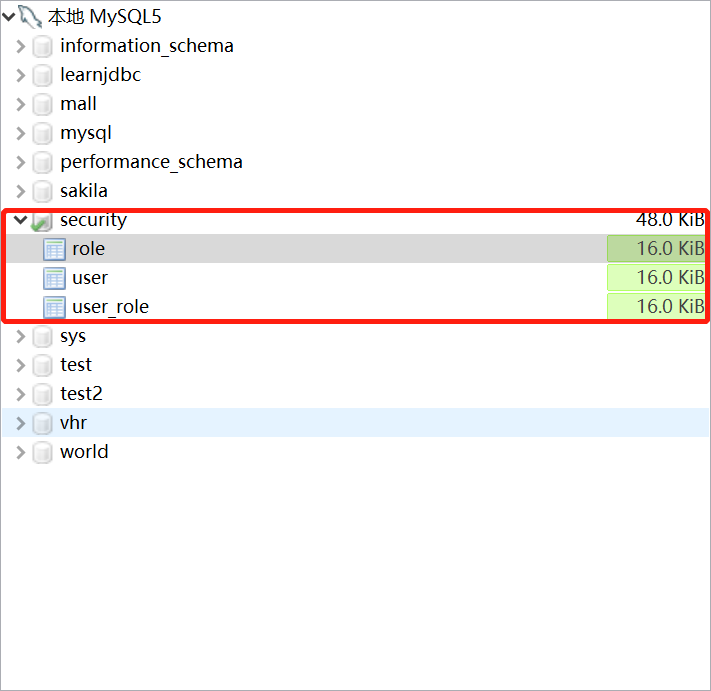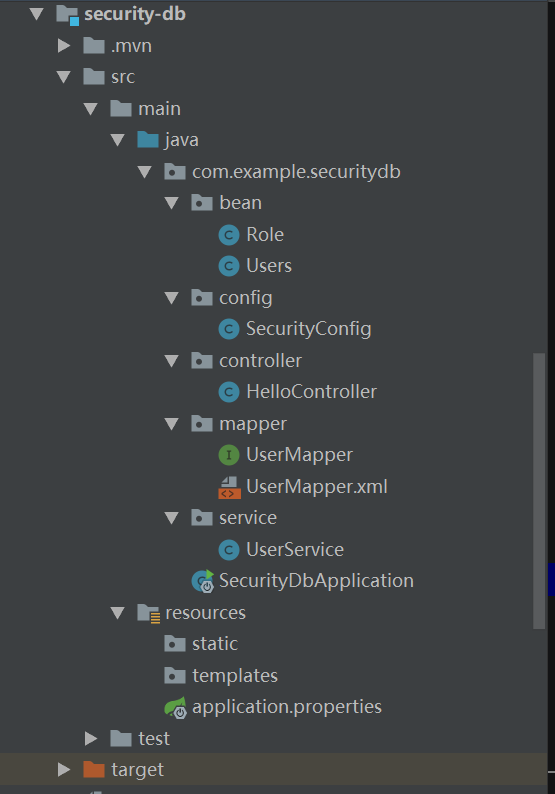准备工作
这里涉及数据库的操作,所以首先需要在数据库中导入相应的表格,这里用的 SQL 文件来自江南一点雨

pom.xml 所需依赖:
<dependency>
<groupId>org.springframework.boot</groupId>
<artifactId>spring-boot-starter-security</artifactId>
</dependency>
<dependency>
<groupId>org.springframework.boot</groupId>
<artifactId>spring-boot-starter-web</artifactId>
</dependency>
<dependency>
<groupId>org.mybatis.spring.boot</groupId>
<artifactId>mybatis-spring-boot-starter</artifactId>
<version>2.1.3</version>
</dependency>
<dependency>
<groupId>mysql</groupId>
<artifactId>mysql-connector-java</artifactId>
<scope>runtime</scope>
<version>8.0.16</version>
</dependency>
<dependency>
<groupId>com.alibaba</groupId>
<artifactId>druid-spring-boot-starter</artifactId>
<version>1.1.23</version>
</dependency>
这里使用 mybatis 操作数据库,关于 mybatis 的基本使用,参考文章:在 Spring Boot 中使用 Mybtais
application.properties 配置文件如下:
spring.datasource.url=jdbc:mysql://localhost:3306/security?serverTimezone=UTC&useUnicode=true&characterEncoding=UTF-8
spring.datasource.username=root
spring.datasource.password=123456
spring.datasource.type=com.alibaba.druid.pool.DruidDataSource
示例
bean
新建两个实体类:Users 和 Role
Users 类继承接口 UserDetails ,具体如下:
@Data
public class Users implements UserDetails {
private Integer id;
private String username;
private String password;
private Boolean enabled;
private Boolean locked;
// 一个用户可能有多个角色
private List<Role> roles;
/**
* 返回用户的所有角色
* @return
*/
@Override
public Collection<? extends GrantedAuthority> getAuthorities() {
List<SimpleGrantedAuthority> authorities = new ArrayList<>();
for (Role role:roles){
authorities.add(new SimpleGrantedAuthority("ROLE_" + role.getName()));
}
return authorities;
}
/**
* 账户是否未过期
* @return
*/
@Override
public boolean isAccountNonExpired() {
return true;
}
/**
* 账户是否未锁定
* @return
*/
@Override
public boolean isAccountNonLocked() {
return !locked;
}
/**
* 密码是否未过期
* @return
*/
@Override
public boolean isCredentialsNonExpired() {
return true;
}
/**
* 是否可用
* @return
*/
@Override
public boolean isEnabled() {
return enabled;
}
}
Role 类如下:
@Data
public class Role {
private Integer id;
private String name;
private String nameZh;
}
mapper
新建接口 UserMapper:
@Mapper
public interface UserMapper {
Users loadUserByUsername(String username);
List<Role> getUserRoleById(Integer id);
}
这里定义了两个方法,通过用户名查询用户,和通过用户id查询用户。
新建和 UserMapper 映射的 xml 文件,实现上面两个方法:
<?xml version="1.0" encoding="UTF-8"?>
<!DOCTYPE mapper
PUBLIC "-//mybatis.org//DTD Mapper 3.0//EN"
"http://www.mybatis.org/dtd/mybatis-3-mapper.dtd">
<mapper namespace="com.example.securitydb.mapper.UserMapper">
<select id="loadUserByUsername" resultType="com.example.securitydb.bean.Users">
select * from user where username=#{username}
</select>
<select id="getUserRoleById" resultType="com.example.securitydb.bean.Role">
select * from role where id in (select rid from user_role where uid=#{id})
</select>
</mapper>
为了使 UserMapper 生效,需要在 pom.xml 文件中配置一下:
<resources>
<resource>
<directory>src/main/java</directory>
<includes>
<include>**/*.xml</include>
</includes>
</resource>
<resource>
<directory>src/main/resources</directory>
</resource>
</resources>
service
新建 UserService 类,继承接口 UserDetailsService,调用 UserMapper 中的两个方法:
@Service
public class UserService implements UserDetailsService {
@Autowired
UserMapper userMapper;
/**
* 根据用户名查询用户对象返回
* 参数为用户名
*/
@Override
public UserDetails loadUserByUsername(String username) throws UsernameNotFoundException {
Users user = userMapper.loadUserByUsername(username);
if (user == null) {
throw new UsernameNotFoundException("用户名不存在!");
}
user.setRoles(userMapper.getUserRoleById(user.getId()));
return user;
}
}
config
新建 SecurityConfig 类,继承 WebSecurityConfigurerAdapter。将 UserService 注入进来,并对不同角色进行权限控制:
@Configuration
public class SecurityConfig extends WebSecurityConfigurerAdapter {
@Autowired
UserService userService;
@Override
protected void configure(AuthenticationManagerBuilder auth) throws Exception {
auth.userDetailsService(userService);
}
@Bean
PasswordEncoder passwordEncoder(){
return new BCryptPasswordEncoder();
}
@Override
protected void configure(HttpSecurity http) throws Exception {
http.authorizeRequests()
// 设置不同角色的访问权限
.antMatchers("/dba/**").hasRole("dba")
.antMatchers("/admin/**").hasRole("admin")
.antMatchers("/user/**").hasRole("user")
// 其他访问路径,只要登录后就可以
.anyRequest().authenticated()
.and()
// 登录表单设置
.formLogin()
.permitAll()
.and()
.csrf().disable();
}
}
关于 SecurityConfig 的配置,参考文章:Spring Security 基础教程 -- HttpSecurity 权限和登录表单配置
controller
写一个 HelloController 类,测试上述权限控制是否生效:
@RestController
public class HelloController {
@GetMapping("/hello")
public String hello(){
return "hello Security!";
}
@GetMapping("/dba/hello")
public String dba(){
return "hello dba!";
}
@GetMapping("/admin/hello")
public String root(){
return "hello admin!";
}
@GetMapping("/user/hello")
public String user(){
return "hello user!";
}
}
此时,完整目录如下:

测试
启动项目,访问 http://localhost:8080/hello,只需要登录任一账号,就能成功访问。
访问 http://localhost:8080/dba/hello,需要角色 dba
访问 http://localhost:8080/admin/hello,需要角色 admin.
每天学习一点点,每天进步一点点。